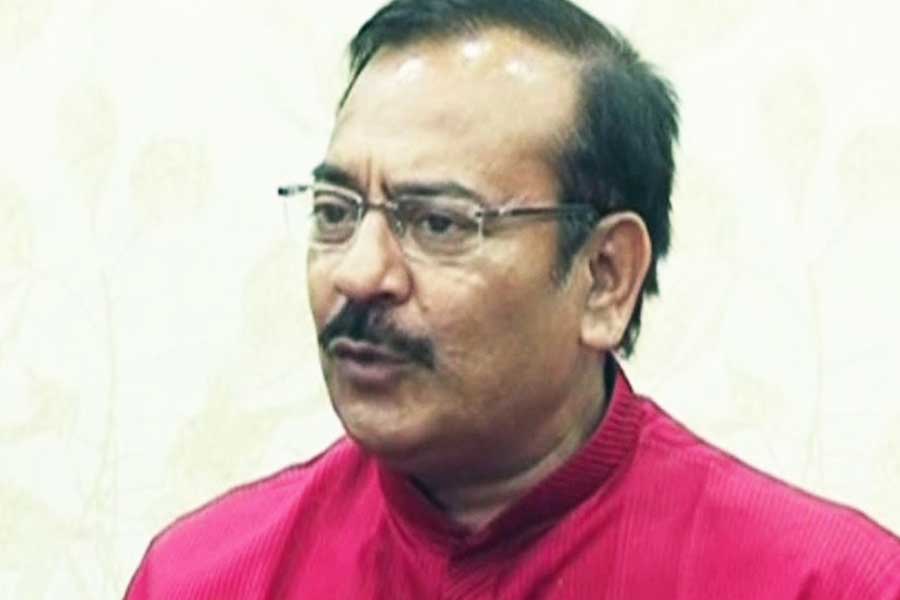
BADAL SIRCAR: TOWARDS A THEATRE OF CONSCIENCE By Anjum Katyal, Sage, Rs 995
"Since we make all that we need/ markets are a waste indeed/ don't let money so enslave us/ Add your voices to our chorus/ Come on, let us share our food/ Come on, let us share our food." - Hattamalar Oparey by Badal Sircar
From the runaway box office hit, Ebong Indrajit, in the early Sixties - which Rustom Bharucha described as the Waiting for Godot of Bengali theatre - followed by another intense play, Sara Rattir, and then Baki Itihas to his bareboned, skeletal 'Third Theatre', which graduated to 'Free Theatre', Badal Sircar's creative odyssey was long and complex. What is really important to note in this context is that the restless and adventurous dramatist said good bye to proscenium theatre when he was an established playwright basking in his success on the stage. He was eager to create something new and disturbing and this restive aspiration drew him towards his Third Theatre.
The basic query of this theatre rested on the impassioned interrogation addressed to the audience, "And you? What are you going to do? Have you decided? You you you" ( Tringsha Satabdi). One Third Theatre play followed another and among these, Michhil was perhaps the most iconic and pulsating. This play has also been a notable success. It was performed first on April 19, 1974 and thereafter 250 times all over the country. In the words of Anjum Katyal, "This play contains many typical features of Badal-da's Third Theatre style, such as: an intimacy with the audience, sharp satirical commentary on society and the status quo, the dream of a more just and equitable tomorrow, a collage-like juxtaposition of sequences, the actors' bodies forming a range of different sculptural images, and humour."
It was during this immensely fruitful phase of the Third Theatre and then 'devised' theatre that Badal Sircar withdrew his name and role from the forefront. Not only did he create a sharp distance from his earlier proscenium plays where he was brandished as the dramatist and the director, but he also referred to the examples of his Third Theatre as essentially collective efforts where he was in no way more important than others.
His dedication to workshops also underlined the importance of this collective responsibility. Indeed, all through his variegated dramatic career, he depended primarily on workshops which were much more strenuous, methodical and revelatory than conventional rehearsals. Commenting on the far-reaching utility of this mode of training, Badal Sircar himself observed, "As I have mentioned before, initially I learnt the workshop process from theatre people of the West but through its application in our group as well as in workshops conducted outside, a methodology began to evolve. In the development of the methodology, I have had, and still have, two great teachers. First, our own theatre practice; and second, the feedback I get from the participants in different workshops." It is a pity that Third Theatre or Free Theatre lost its biting edge in the 2000s and Badal Sircar's dream of replacing proscenium with free space was not realized.
Badal Sircar was also rigorously honest. He knew that his innovative dramaturgy, despite its rebellious content, was meant primarily for the middle class. He wanted to shake off the stupor of this complacent class. Though a Marxist and a rebel, he could well comprehend that his productions, no matter how 'free' they were, would not have any noticeable impact on the peasantry and the proletariat. In order to fill this crucial gap, he advocated that the working class, à la Meyerhold, should write its own plays delineating its own agony. His words in this connection were quite categorical: "The ultimate answer... is not for a city group to prepare plays for and about the working people. The working people - factory workers, peasants, the landless labourers - will have to make and perform their own plays.... This process, of course, can become widespread only when the socio-economic emancipation of the working class has also spread widely." While dissecting this statement, Anjum Katyal has aptly observed that his dream and vision were the progress of this gradual socio-economic emancipation. She has written, "One could argue that it was this 'socio-economic emancipation' that he hoped to further by taking his plays to them... Nishat Jahan of Bangladesh, for example, talks of his highly successful workshops with rural NGO groups doing rights awareness-building through theatre in the late 1990s."
Nishat Jahan's observation reminds us that Badal Sircar's innovative dramaturgy did not remain confined within the borders of India. Indefatigable that he was, he delivered lectures, conducted workshops and staged performances in open spaces throughout the subcontinent. He included Pakistan and Bangladesh in his creative itinerary. Hence, it can be claimed without exaggeration that it is well-nigh difficult to find a single dramatist who is so widely performed, whose theories of form and approach still work their way into current practice and who as a pedagogue has inspired myriad theatre works through his workshops.
Not only enthusiastic theatre groups always craving for something new and bold, but also renowned dramatists and directors gratefully acknowledged the influence and impact of Badal Sircar on their dramatic praxis. To offer a few remarkable examples: Girish Karnad has said that Badal Sircar's Ebong Indrajit taught him about the fluidity of structure; famous Manipuri director, Heisnam Kanhailal, acknowledged that Badal Sircar placed him on the right track. Even Naseeruddin Shah, who belongs to an entirely different school of theatre, has said, "My theatre is also moving towards Sircar's theatre".
The extent of his greatness can be gauged when one considers the fact that his dramaturgy was diametrically different from Brecht's theatre of alienation. He knowingly challenged the all-pervasive Brecht and propagated an "anti-establishment counter culture, challenging normative middle-class mores and complacency, an attempt at conscientisation... It drew on the daily reality of the common man, the entire gamut of oppression, corruption, injustice, power politics, struggle, disillusionment, despairing hope, battered idealism and confused questioning that all of us experience as we grapple with the everyday." In fact, both Brecht and Badal Sircar endeavoured to rouse the middle class in different ways. While Brecht wanted the impressionistic audience to maintain a strict distance from the actual production, so that they could judge using their own critical faculty and intelligence, Badal Sircar sought to obliterate the distance between the audience and the production and to herald a theatre of assimilation where the audience with their reaction becomes a part and parcel of the entire dramatic process.
One feels quite dejected and to a trifle extent ashamed to recall that this uncompromising thespian, who refused to seek patronage or favour from any quarter, did not receive the recognition due to him in his own state, West Bengal. Playwrights, actors and directors who constitute the world of Bengali theatre appeared to be indifferent to his weak and struggling condition in the first decade of this century. But Maharashtra accorded to him the honour he richly deserved. One needs to go back to Amol Palekar's Foreword to this book to evaluate what his friends and admirers in Mumbai and Pune did when he direly needed help and support. Recalling their engagement, Amol Palekar has written, "All the theatre stalwarts, such as Dubey, Vijay Tendulkar, Amrish Puri, Kulbhushan Kharbanda, Mahesh Elkunchwar, Nana Patekar and many others participated in the [Badal Sircar] festival... On behalf of the entire theatre world, we handed over a significant amount to Badal-da as his 80th birthday gift, which he could not refuse."
One could conclude by saying that the name of this theatre personality, who converted street corners, parks and bare rooms to rebellious spaces or 'non-stages', needs to be pronounced with those of two other greats, Sombhu Mitra and Utpal Dutt. In fact, Badal Sircar took that crucial step forward, which even Mitra and Dutt did not risk taking, by turning his surrounding space into dramatic locations where the beaten and the battered condition of the oppressed was dramatized. His relentless dramaturgy created a genuine 'theatre of conscience' whose whiplash cracked the smug amnesia of the middle class and invoked us to extend to him the honour he so richly deserved. Did we confer on him this deserving honour? That is the question. The author has done her job by writing this excellent critique, both impassioned and meticulous. Now, it is our turn to utilize and honour that legacy which Badal Sircar left for us.










